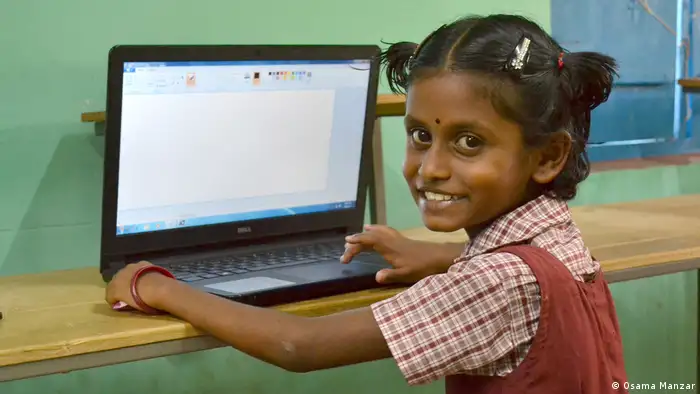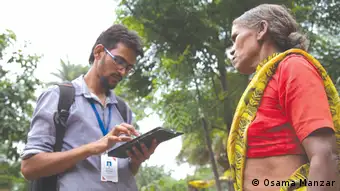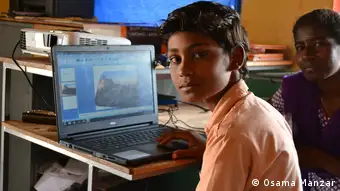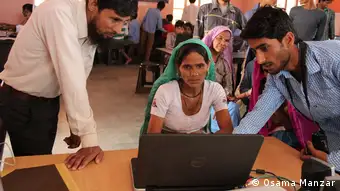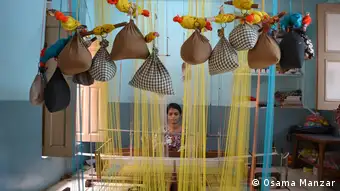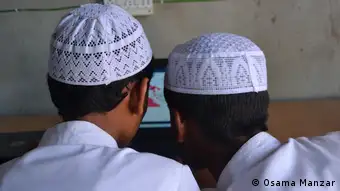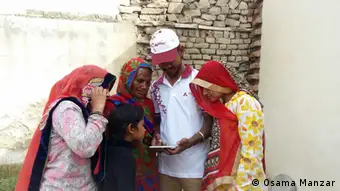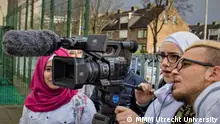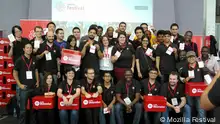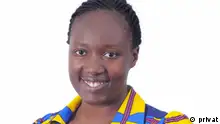MILEN
Most of India is poor, because information does not go to the poor!
In 2000, when nobody in India was thinking about taking the Internet to the villages, Osama Manzar began his mission to eradicate information poverty using digital tools. Read the interview with the digital entrepreneur.
TheDigital Empowerment Foundation (DEF) was founded with the vision to end information poverty and social backwardness by bringing about a digital revolution. In this interview with #mediadev, MILEN member, entrepreneur, impact speaker, author, angel investor, global leader and DEF-founder Osama Manzar talks about his plan to empower citizens through media literacy.
#mediadev: How did you come up with the idea of designing special media literacy projects for rural communities?
The idea was born back in 2000 when I was researching for my first book, Internet Economy of India, and I came across the then recently introduced phrase "digital divide". It remained stuck in my thoughts for days and months to come. Unfortunately, that phrase is still popular and largely valid in a world where half the population is still not connected to the Internet. At that time, 70 per cent of our population was living in rural areas; the majority of our population had barely any means to access information that could empower them to avail themselves of rights, entitlements and opportunities. It occurred to me that India and its people are not poor because we have less money or poor resources. We are poor because we have a huge population that does not have access to timely and relevant information. Yet I could see a bright light at the end of the tunnel. I visualized a scenario where every household in India was connected to the internet; where every household had access to a digital tool; where at least one person in every household was digitally literate; where all government institutions were online; where every piece of government information was available online; where every household in India had access to this information irrespective of geography, caste or gender.
#mediadev: Why do you think digitalization is so important in reducing poverty?
Most of India is poor. In my opinion we are not poor because of anything else, but because information does not flow properly and information does not go to the poorest of the poor. They don’t know how to use information, they don´t know how to use it for their benefit, for their right, for their entitlement, for anything. And this actually hit me so hard. If I do not have water, do not have food, do not have land, do not have my rights, I do not have my entitlement – it is all because of information. If I am not getting my ration, my food which government says I am entitled to, it is not about food, it is about information. It is about food that is available, and I have a right to get 15 kgs of rice or 20 kgs of wheat and so many kgs of sugar, and the fact that I need a ration-card and then I need to fill in a form and go to get it – all those are information processes. It is such a strong tool of democratization and it is such a democratic tool that everybody can use and access, if they wish and they can afford it. You can also produce your information and consume information.
#mediadev: How does the Digital Empowerment Foundation work?
It’s a 400-member big family! Our primary model of work is to set up a physical resource center in a village. This resource center is well equipped with all the necessary digital tools and technologies, including tablets, laptops, printer-scanner, digital camera, power back-up and wireless broadband connectivity. The resource center is managed by a local community member who then uses these tools to serve his or her community with digital literacy support, digital services, information services, citizen services and business development services, to create an information-rich society.
#mediadev: How do illiterate people know how to use the Internet or other digital tools and devices?
You can imagine that once you have access to the information itself - if is not in the language that I know and it is not in the medium that I understand and it is not in the script that is meant for me, then I am so challenged. Look at India where 50% are functionally illiterate and even more are illiterate and more than 80-90% are digitally illiterate. Now if you think, mobile has become an audiovisual tool, you realize that people do not have to become written literate or media literate or language literate. They can record a voice and send it, they can receive files, video files, they can use emoticons and all that. Digital infrastructure can cross the physical infrastructure and can enable people to ask for their rights, if they don’t have it democratically and can´t reach out to the larger masses of the country and the world to say that I am not getting what I am entitled to. They have a lot of knowledge and wisdom to share. We have so many traditions and arts and craft and culture and folk and history and heritage and so many things. Those are such enriching things. It is very important that we understand that the country, or the civilization or the people who have been illiterate - we call them illiterate, which is a shame, because they are not actually illiterate, they are medium-illiterate. If I do not read and write, that does not mean I do not know anything. But asking me to use paper and pen as a technology-tool to express my knowledge is something I do not know. But if you talk to me, I can verbally talk to you; I can orally talk to you, I can talk in my language, in my ways or dialects or whatever. But the point is – you do not want to understand my dialect, you do not want to understand my language, you do not want to take my information orally. And that’s how the world has been ruling the masses, by using the medium as a tool to tell you that you are illiterate and therefore not even considered equal. That’s an irony. So for me digital is a very strong tool, which actually has the capability to enable the masses to become not only information consumers, but also become information producers and knowledge producers, and to ask for equity or equitability at any point of time where knowledge is shared.
#mediadev: If you give the medium-illiterate digital access, how do they know how to get the information they need?
Maybe it is very difficult for the government or the industry or society to put technological tools or access tools or devices in each and every hand. It is impossible almost. What is very important is to create public access points where people can go. For example, not everybody can have cars. And therefore there is public transport which carries everybody together from one location to the other and in various forms. Similarly, we can have a very strong open public space with broadband enablement, with digital devices, where people can come and access their rights. The point is, 20% of the Indian population who live in remote or rural areas are actually physically disconnected so much, and now they are also digitally disconnected. When most of the information and most of the government entitlements and information has gone onto the Internet and web, how do they access it if the infrastructure is not available?
#mediadev: How do people in remote areas react if you come and connect the village to the Internet?
They get very excited, because everybody has heard of the Internet, everybody wants their children to get access to digital education, or the Internet, or social media. When we start a digital resource center or a digital access point or a broadband access point, the younger people just come to us. What is very beautiful to experience is that girls, females, women are coming. In our country women do not go to faraway places, they are stuck in their areas. In many communities they don´t even get out of the house, they do only the domestic work at adolescent age which is a very great pity. But the point is, when these kinds of centers are opened, they are seen as safe space. So there is a lot of cultural welcome to this kind of resource centers and access points from the educational perspective and awareness perspective, or even entertainment perspective or from the perspective that you have access to necessities like getting photocopying done, your digital photography done or access to the Internet for filing a form or all kinds of entitlements or examinations, or applying for jobs. All of that available now, close to the doorstep, is a welcoming thing for them.
#mediadev: Do people in remote areas easily accept new technologies?
When we go to remote areas, especially tribal areas, there is a lot of apprehension in touching computers or going online or that kind of thing - or touching a keyboard. One girl said: “If I touch a keyboard I am afraid that my fingers will go in and never come out”. Then somebody said that he did not know how to switch on because he thought it may blast like a bomb when he touches the wrong button. Somebody said: “I was touching some keyboard and then the scripts suddenly vanished, and I thought that I have destroyed the computer.” Somebody said: “There is a mobile in my home, but that is only allowed to be touched by my brother, because he is ill and my father does not allow me to touch a computer or a laptop or a mobile or something, because he said that this is not the business of a girl, because you may just break it or you can’t handle it”. There is a lot of patriarchal ways of looking at these kinds of things. Men always think that they have a right to touch anything new that comes into society whether it is a car or a bike or ideas or a cycle or whatever. We are promoting media literacy, information literacy by sharing our resources. We had this patiently made curriculum. But then we learned that nobody wants to see that curriculum. They are learning computer faster on their own rather than being told what to do. The only thing they wanted to know is what to touch and what not to touch and then they would be apprehensive. They were learning peer to peer. One girl might know a little extra, she might be learning a bit faster and suddenly somebody asks: How come you are watching a movie? And then she says: You click those four buttons there and you will get there. The other thing we learned is that people learn by doing, by working and not by instruction. Therefore we developed a box and called it START. It is a box with all the digital or all information or Internet kind of literacy tools, where you do not even touch computers, you play games and you learn about computers or IT or the Internet or social media or web-security or online-security and then you start getting into activities and that is how you learn.
#mediadev: Do people with traditional skills use the computer to archive their knowledge?
People with traditional skills have been actually leaving those skills and looking for other jobs, because they think it is too hardworking, it’s not paying, most of the people who are middlemen they take all the money. Especially in the area of handlooms, because India is very famous for handlooms. We had a chance or a grant from the government to do digital intervention experiments in one of the handlooms clusters. We provided weavers with access, broadband; we provided them with cat-cam software which is actually designing software. We taught them how to for example scan the weaving designs and convert them to new designs. We connected the local health centers with the doctors who are far away on video conferences, we organized digital literacy courses for all their family members, we organized special social media training for them, and we organized English-learning courses for them. We organized alternative job-orientated skills for them so that if they don’t want to continue with their weaving they can go and become a hardware engineer or software engineer. We also organized photo studies to do the photographing of their clothing in such a way that they can present them better. We taught them how to reach the market through Internet and web searches and social media searching. It is 4, 5 years of experience. Everybody now has got a Facebook page for selling their products and connecting to the market. Now, half the cluster has got broadband connectivity. All this actually created a deposit of 30 000 to 40 000 designs. Hundreds of the weavers went online having their pages. It created so much attraction to the outside market that Bollywood movies came and made movies in their area. So, what we learned is that if you work in a traditional cluster, you not only preserve it, you also make it economically better and can charge better prices and get more orders, if you are connected to the worldwide market and the nationwide market.
#mediadev: This is a touching story!
There are so many touching stories. There is a place in western India, in a province or a state called Gujarat. And the place is famous for desert-salt. It is a huge area. They are on the seacoast and they become sea for 4, 5 months, and then the water recedes and they become marshland and it becomes dry and it becomes salty land. There is a tribe. They shift through that desert for about 6, 7 months and they actually do salt farming. They shift with their whole family and they are tribals. They live away from civilization for six months every year, in the desert. They dig wells and they take out water, which actually is salt. It is not an easy process, as you can imagine. There is no access to information or (normal) life for them. So what we created is a special vehicle and we put a Wi-Fi-antenna on it and we created a Wi-Fi link with outside the area. We linked the Wi-Fi in such a way that the vehicle could reach them and in it we put LCD screens and things like that, tablets. All the salt workers would call all their family members and children. They had access to education right there in the desert. And they were so happy to have access and to play with their tablets. So the joy on their face was quite effective. We cannot support them now anymore. But the good thing is: Government has now created unused buses, decorated them as a school and they are placing those buses in the desert for the children to come.
#mediadev: Let’s talk about MILEN (Media and Information Literacy Expert Network). You are a very active member, although your time is already pretty limited.
MILEN is very beautiful. It is very interesting from the perspective that now mobility, access to information, access to the Internet has reached half the world. So it’s a huge mass that is using digital connectivity and we are producing information and consuming information and news and media in various forms. It is very important that we also know what we are consuming and what we should not consume, and what is right and what is wrong and what is harmful and what is beneficial. And from that perspective: If you bring the diversity of various people who work in various regions, like I work in Asia and India, somebody works in East Asia, somebody is working in Africa, somebody in Europe, somebody in Central Asia, somebody in Latin America and all that; it is very interesting because they all bring different perspectives to the table. And it is very interesting because we can learn from each other – what are the tools you are using, what are the tools I am using, what are the tools someone else is using from the linguistic perspective, from the platform perspective, from the context perspective, from the media perspective, from the experience perspective. How do you actually leverage all the experience together and bring it to the larger scale of masses? So it’s very interesting, we are getting benefits. We’ve learned from other network members that they are also using something very interesting which we want to adopt and we want to textualise. Similarly, we have to expose our product in such a way that other network members can take it, and can apply it in their areas.
We are also thinking that a MILEN kind of network can also impact a lot on advocacy and policy decisions worldwide. If voices of different countries speak, obviously you can’t ignore them. So there is a possibility that we might be able to create a larger impact on various levels of policy and advocacy, in various governments and in various countries. The other thing is, how do we take it to the next level of activity, where masses are getting connected, how to make people aware, to consume information and how to consume information, to educate them. It is a huge task for us considering that the whole world is learning about hate-speech and fake news and misinformation and disinformation, because everybody has got access to information and tools. There is almost no control over who is producing what. In the written world there was still a lot of control, only a few people were producing. Now the masses are producing information. Earlier masses were consuming information, now masses are producing information. MILEN can look at those challenges and find the solution for the benefit of the society. That’s what we are hoping.
#mediadev: What have been the biggest changes since the foundation phase?
What was India like in 2002? Internet was only about seven years old in the country. Mobile was still struggling to achieve widespread penetration; there were just 13 million mobile subscriptions in India. Service providers were facing the challenges of trying to minimize the cost of per-call rates to geometrically increase the volume of customers. None of the major Acts, such as theRight to Information (2005), the Right to Education (2009), the National Food Security Act (2013) and Mahatma Gandhi National Rural Employment Guarantee Act (2005), were as yet in place. There were also just 82,409 fixed broadband subscriptions in India. Access to digital tools was limited and access to the Internet and the information it held was even lower in the one billion-plus country.
It is 2018 now. Our foundation is 15 years old. Fixed broadband subscriptions have gone up from 82,409 users in 2002 to more than 18,733,400 users today. Mobile subscriptions, too, have gone up from 13 million in 2002 to more than 1 billion today. Internet users have gone up from 1.5 per cent to 29 per cent of India’s population. Yet almost 70 per cent of our population is still unconnected. ‘Digital divide’ is still a popular phrase and a plaguing challenge.
However, the incumbent government’s push for the Digital India program and the falling rates of data plans in the country, coupled with affordable smartphones, has created much more awareness about digital inclusion and its benefits in the country.
#mediadev: What have been (or still are) the biggest obstacles to your work?
People often ask us, "Why do you want to give the poor access to the Internet when the bigger concern is to provide them with access to food, clothing and shelter?" This has been a major challenge for us. The other, of course, is the population and vastness of the country. In the last 15 years, the Digital Empowerment Foundation has digitally enabled over 5,000,000 people in more than 300 villages, but it’s barely a dent in our large unconnected population.And the Indian education system, especially at the pre-university level, is largely based on rote learning rather than critical thinking. In such a scenario, media literacy does not really come into play, unfortunately. Even in the government’s digital learning agenda, media literacy does not get a mention; it’s more about learning the functionality of digital tools to access content, rather than analyzing it or creating new content.
- Date 19.10.2018
- Author Petra Aldenrath
- Feedback: Send us your feedback.
- Print Print this page
- Permalink https://p.dw.com/p/36oL2
- Date 19.10.2018
- Author Petra Aldenrath
- Send us your feedback.
- Print Print this page
- Permalink https://p.dw.com/p/36oL2

